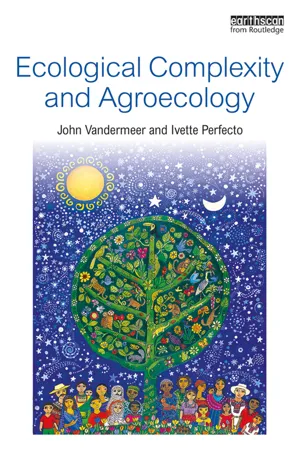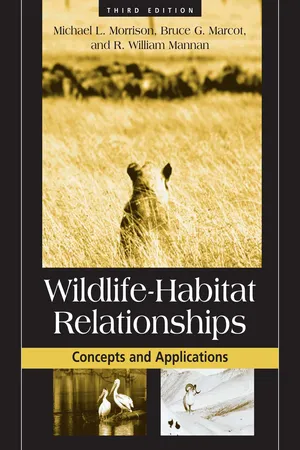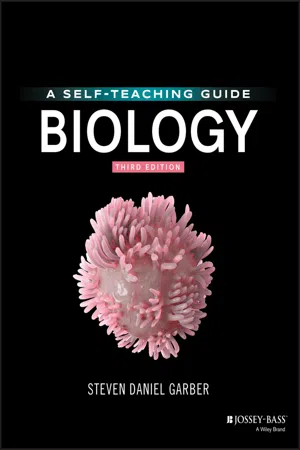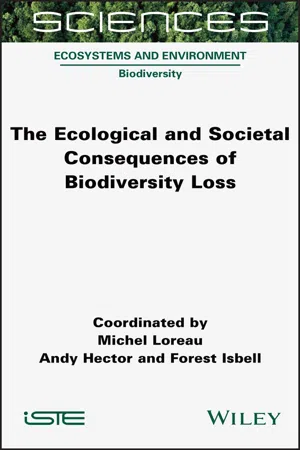Ecological Niche
An ecological niche refers to the role and position of a species within its environment, including its interactions with both biotic and abiotic factors. It encompasses the resources a species uses, its interactions with other species, and its impact on the ecosystem. Essentially, it describes how an organism fits into its ecological community.
6 Key excerpts on "Ecological Niche"
- eBook - ePub
- John Vandermeer, Ivette Perfecto(Authors)
- 2017(Publication Date)
- Routledge(Publisher)
...These conditions, in modern parlance, define the limits of the Ecological Niche of that pest or that crop. The idea gained scientific legitimacy through the work of two field ecologists, and, not surprisingly, took on slightly different connotations for both of them. One of the acknowledged founders of the Western tradition in ecology was American ecologist Joseph Grinnell, who conceptualized the niche as a kind of physico-chemical envelope within which the species could exist. Taking a slightly different perspective, British ecologist Charles Elton had the idea that a species had some sort of a “role” to play in the ecosystem. Elton’s conceptualization of the niche reflected more modern ideas such as “response and effect” 7 or niche construction. 8 However, the modern niche framework must be attributed to Hutchinson, who formulated the idea as a “multidimensional hypervolume,” a formulation that seems to have survived and become a standard of contemporary ecological literature. 9 Beginning with ideas akin to those of Grinnell, Hutchinson suggested we contemplate the limits beyond which a particular species is unable to persist. His formulation was perhaps a bit more physico-chemical than it needed to be, but for heuristic purposes it suffices to imagine a temperature range within which some particular species is able to survive. An arctic fish, for example, will survive over a range of average temperatures that is considerably lower than the range over which a tropical fish will survive. Likewise, an ocean fish will survive over a range of average salinity that is considerably higher than the range over which a freshwater fish will survive. The situation becomes interesting when the niche ranges of two species overlap, as suggested on the temperature axis in Figure 2.9, and on both temperature and salinity in Figure 2.9c...
- eBook - ePub
Ecology
From Individuals to Ecosystems
- Michael Begon, Colin R. Townsend(Authors)
- 2020(Publication Date)
- Wiley(Publisher)
...Each habitat, however, provides many different niches: many other organisms also live in the gut, the garden or the lake – and with quite different lifestyles. The word niche began to gain its present scientific meaning when Elton wrote in 1933 that the niche of an organism is its mode of life ‘in the sense that we speak of trades or jobs or professions in a human community’. The niche of an organism started to be used to describe how, rather than just where, an organism lives. niche dimensions The modern concept of the niche was proposed by Hutchinson in 1957 to address the ways in which tolerances and requirements interact to define the conditions (this chapter) and resources (Chapter 3) needed by an individual of a species in order to practice its way of life. Temperature, for instance, limits the growth and reproduction of all organisms, but different organisms tolerate different ranges of temperature. This range is one dimension of an organism’s Ecological Niche. Figure 2.2 a shows how species of passerine birds in North America vary in this dimension of their niche. But there are many such dimensions of a species’ niche – its tolerance of various other conditions (relative humidity, pH, wind speed, water flow and so on) and its need for various resources. Clearly the real niche of a species must be multi dimensional. Figure 2.2 The Ecological Niche in one, two and three dimensions. (a) A niche in one dimension showing the thermal range of passerine birds in southern Canada and the contiguous USA recorded during the North American Breeding Bird Survey 2002–06 in relation to minimum and maximum thermal limits of an average of 10 occurrence locations for each species (measured in each case as mean springtime breeding season temperature). (b) A niche in two dimensions for the sand shrimp (Crangon septemspinosa) showing the fate of egg‐bearing females in aerated water at a range of temperatures and salinities...
- eBook - ePub
- Oswald J. Schmitz(Author)
- 2013(Publication Date)
- Island Press(Publisher)
...Natural ecological systems differ from the container system in that they are comprised of vastly more species with many more interdependencies than those found in the glass container. Understanding these complex interdependencies is the fundamental purpose of that subfield of biology known as ecology. What Is Ecology? Ecology is a science aimed at understanding: The processes by which living organisms interact with each other and with the physical and chemical components of their surrounding environment. The way those processes lead to patterns in the geographical distribution and abundance of different kinds of organisms. The result of the process leading to a pattern is the assembly of a natural economy. In ecology such a natural economy is formally called an ecosystem. Ecosystems encapsulate many forms of biological diversity (also called biodiversity). Biodiversity results from a variety among individuals comprising a species owing to sex, age, and genetic differences among those individuals. It also stems from differences between species living together in a geographic location. For example, species may differ in their functional roles (e.g., plant, herbivore, carnivore) and the efficiency with which each carries out its function in different environmental conditions. Biodiversity also arises from the myriad ways that species are linked to each other in ecosystems. As a consequence of these many forms of biodiversity, there is considerable complexity underlying the structure of ecosystems.The challenge in ecology is resolving this complexity. Biodiversity results from a variety among individuals comprising a species due to sex, age, and ge- netic differences; from differences between species living together in a geographic location; and from the myriad ways that species are linked to each other in ecosystems. As a consequence of these many forms of biodiversity, there is consider- able complexity underlying the structure of ecosystems...
- eBook - ePub
Wildlife-Habitat Relationships
Concepts and Applications
- Michael L. Morrison, Bruce Marcot, William Mannan(Authors)
- 2012(Publication Date)
- Island Press(Publisher)
...Rather, our point is that different questions are best answered at different scales, and that some questions beg knowledge at multiple scales. In addition, many questions on habitat relationships would likely need to incorporate both intensive and extensive variables. For example, although determining the food requirements of a species (an intensive variable) is often necessary, the availability of food might be determined by intra- or interspecific population densities (an extensive variable). Our argument is that extreme care must be taken when choosing variables, care that includes knowledge of how animals perceive their environment; experimentation will likely be warranted in many cases. Habitat and Niche Related and central to our discussion of habitat is the concept of the niche. Like habitat, the concept of the niche has been the subject of much debate and certainly falls under the same criticisms concerning operationalization of terms noted above (Peters 1991). Much of the problem with study of the niche is the lack of an accepted operational definition. Arthur (1987) reviewed the niche concept. He noted the range of definitions stemming from Grinnell’s (1917) description of the niche as the ultimate distributional unit, to Elton’s (1927) primarily behavioral concept, to Hutchinson’s (1978) n -dimensional construct (for behavior and distribution). Leibold (1995) expanded on these definitions and the historical development of the niche, concluding that Elton’s view and that of MacArthur and Levins (1967) were oriented toward describing how an organism affects the environment by consuming resources and by serving as a resource for higher trophic levels. In contrast, Grinnell’s view of the niche emphasized the environmental requirements of the organism. Arthur (1987) concluded that, to be useful, the accepted concept must be simple and quantifiable...
- eBook - ePub
Biology
A Self-Teaching Guide
- Steven D. Garber(Author)
- 2020(Publication Date)
- Jossey-Bass(Publisher)
...The amount of light penetrating through any environment is important, as are the seasonal fluctuations with regard to any of the above variables. Just as aquatic organisms are adapted to specific sets of variables, certain plants grow only on special soil types, and some animals live only in areas where there are certain associated vegetation patterns. Air quality is also important. An organism's habitat is the place where it lives. The variables mentioned above determine the characteristics of that habitat. An organism's niche is what the organism does. A niche is described by defining an organism in terms of its role in the ecosystem. Niches may be described using as many variables as one examines. For instance, a niche might be represented in terms of where an animal forages, when it forages, and what it forages on. This could be contrasted to the niches of related species living in the same general area to see if their niches vary according to these variables. The range of variables one examines is practically limitless. POPULATIONS AND COMMUNITIES All the members of a certain species living in a specific area at a specific time are defined as a population. Each of the populations living in a given area constitutes a community. Changes in a population's size (number of individuals in the population) are due to births, deaths, immigration, or emigration. Should births and immigrations exceed deaths and emigration, the population will grow. Likewise, the opposite is also true: If the total number of deaths and individuals emigrating from the population exceed the gain from births and immigrating individuals, the population will decrease in size. The density of a population is calculated by counting the number of individuals per particular area (or volume). Dispersion is a parameter used for understanding the type of spacing of individuals within the population...
- Michel Loreau, Andy Hector, Forest Isbell(Authors)
- 2022(Publication Date)
- Wiley-ISTE(Publisher)
...Introduction The Ecological and Societal Consequences of Biodiversity Loss Michel LOREAU 1, Andy HECTOR 2, and Forest ISBELL 3 1 Theoretical and Experimental Ecology Station, CNRS, Moulis, France 2 University of Oxford, UK 3 University of Minnesota, St. Paul, USA One of the distinctive and fascinating features of ecological systems is their extraordinary complexity. An ecosystem is often composed of thousands of different species that interact in myriad ways at the scale of a single hectare. Each species is composed of many individuals that vary due to differences in their genetics and their particular experience of their local environment. These complex local systems are strongly connected to each other, and aggregate into larger and larger entities, from the landscape scale to that of the entire biosphere, where it becomes evident that they exert a major influence on the physical and chemical properties of our planet. How can such enormously complex systems be studied? During the second half of the 20th century, two increasingly divergent approaches to ecological systems developed within ecology, which have gradually led to two largely distinct disciplines, community ecology and ecosystem ecology. A community is defined broadly as a set of species that live together in some place. The focus in community ecology has traditionally been on species diversity: what exogenous and endogenous forces lead to more or less diverse communities? How do species interactions constrain the number of species that can coexist? What patterns emerge from these interactions? An ecosystem is the entire system of biotic and abiotic components that interact in some place. The ecosystem concept is broader than the community concept because it includes a wide range of biological, physical, and chemical processes that connect organisms and their environment...





